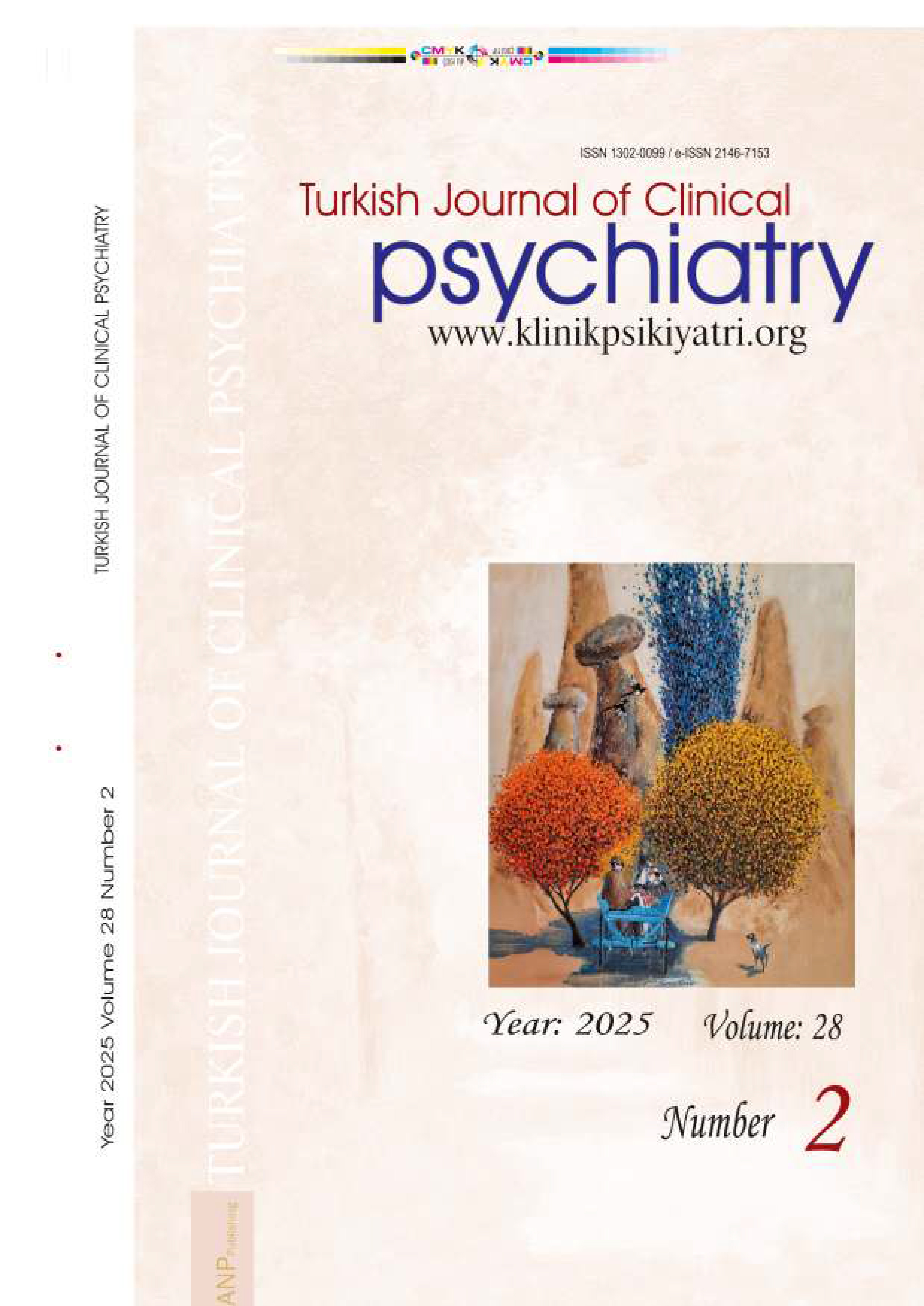





Volume: 14 Issue: 1 - 2011
| RESEARCH ARTICLE | |
| 1. | Test Anxiety and Related Psychiatric Symptoms Önder Kavakcı, Ayşegül Selcen Güler, Selma Çetinkaya Pages 7 - 16 Objectives: Test anxiety is an important problem for students and has an adverse effect on academic performance. There have been few studies on the relationship of test anxiety with a number of psychopathologies.The objective of this study was to investigate the relationship between test anxiety, attention deficit hyperactivity disorder, anxiety and depression. Method: 171 students representative of the student population of the medical faculty, selected by simple random sampling, completed the sociodemographic form, Adult ADHD Self-Report Scale (ASRS), Wender Utah Rating Scale (WURS), Liebowitz Social Anxiety Scale (LSAS), State-Trait Anxiety Inventory (STAI), Beck Depression Inventory (BDI) and Test Anxiet Inventory (TAI). Results: 15.8% of the students had test anxiety and 2.3% had anxiety above established scale thresholds. 4.1% of the sample were identified as ADHD according to ASRS where 14.8% had depression according to BDI. TAI scores, LSAS anxiety scores, Trait Anxiety scores were significantly higher in girls than boys. TAI scores was positively correlated with ASRS, WURS, LSAS anxiety subscale, LSAS avoidance subscale, BDI and Trait Anxiety scores. Students identified as ADHD according to ASRS and WURS had higher levels of test anxiety, trait anxiety, depression and social anxiety scores than those who were not identified as having ADHD. WURS, LSAS and BDI scores were independent predictors of test anxiety. Conclusion: Assesment for accompanying disorders, particularly ADHD, depression and social anxiety should be included in clinical inquiry in students presending with test anxiety. |
| 2. | Investigating of the Relationships Between Adults' Subjective Well-being and Primary-Secondary Capabilities with Respect to Positive Psychotherapy AN Eryilmaz Pages 17 - 28 Objectives: In psychology, happiness is treated with the concept of subjective well-being, which means an individual's evaluation of and judgment about his life. Subjective well-being is not a single dimensional structure. It has three important elements: Positive affect, negative affect and life satisfaction. Positive Psychotherapy is based on balance model. Individuals cope with the conflictions they face by their bodies, their achievements, their social contact and fantasy. The aim of Positive Psychotherapy is to widen the opportunity with which he copes the conflictions. The goals of all therapy methods help individuals in order to get rid of pathologies and also live happily. So many therapy methods and assumptions put into practice with respect to these goals. This study examines the association between the positive psychotherapy constructs and subjective well being. Method: A total of 182 individuals- between ages 25-40- (94 female and 88 male) completed Wiesbaden's Inventory of Positive Psychotherapy and Family Therapy, Positive-Negative Affect Scale, and also Life Satisfaction Scale. Multiple regression analysis method was conducted in order to investigate the relationship between variables. Results: Regression analysis shows that achievement and trustworthiness are important predictors of subjective well-being as secondary capabilities. Time and hope are important predictors of subjective well-being as primary capabilities. Conclusion: Achievement, trustworthiness, time and hope capabilities are important for adults' subjective well-being. So, it is concluded that the results of this study can be used in therapeutic process. |
| 3. | Psycho-social Markers of Smoking, and the Relationships Between Smoking and Life Satisfaction, and Subjective Well-being in the Years of Transition to Adulthood Hasan Atak Pages 29 - 43 Objectives: This study produced to investigate psychosocial markers of smoking, and to expose the relationships between smoking and life satisfaction, and subjective well-being among young people who are in the years of transition to adulthood. Method: Cross-sectional research design was used in this descriptive study. The participants consisted of 96 female (43.2%) and 126 male (56.8%) who are between 19-26 years, totally 222 people. Extended Objective Measure of Ego Identity Status, Multi-Measure Agentic Personality Scale, Rosenberg Self-Esteem Scale, Satisfaction with Life Scale and Positive and Negative Affect Scale were used for gathering data. In data analysis, frequencies, percentages, and path analysis with observed variables was used. Results: Most of the participants smoke, and they start to smoke in the high school years namely adolescence. According to model analysis, it was shown significant negative relationship between smoking and selfesteem, interpersonal achievement identity status, individuation types, and self-identification. The participants whose fathers, mothers, and friends are smokers, smoke more than the other participants; the participants who have default identity status, moratorium identity status, and identity confusion, and lower income smoke more than the others. It was found significant negative relationship between smoking and both life satisfaction, and subjective well-being. Conclusion: Considering the findings, it can be said that the findings of this study are similar to the literature. Finally, it can be expressed that intervention studies must carry on not only high school students but also primary school and college students. |
| 4. | An Evaiution of Psychiatric Consultation Services in a Training Hospital Ayşe Köroğlu, Fatmagül Helvacı Çelik, Murat Aslan, Çiçek Hocaoğlu Pages 44 - 50 Objectives: In this study the distribution of psychiatric consultation in a training and research hospital was evaluated in terms of socio-demographic characteristics, the clinics which referred consultation, reasons for referral, psychiatric diagnoses and treatments. Method: The psychiatric assessments of the patients, at the age of 18 and over, who were hospitalized in Rize Training and Research Hospital from 1st July, 2009 to 30th June, 2010 and required to get psychiatric consultation was recorded on a structured form. Results: Study group consisted of 405 inpatients treated in other clinics and required to get psychiatric consultation. The average age of the patients is 43 ±18.6 and 137 ( 35.4 %) of them are male and 268 ( 64.6%) of them are female. The most frequent referrals were from internal medicine (24.2%), chest diseases (15.2%), and neurosurgery (13.6%) clinics. The most frequent causes of psychiatric consultations were agitation (27.3%), depressive symptoms (17.0%), and evaluation of the patients without indicating any reason for consultation referral (16.8%) and suicide attempts (14.1%). The distribution of psychiatric diagnoses was depression (31.8%), organic mental disorders (18.3%), anxiety disorders (15.0%) and adjustment disorders (14.3%). Among all patients 65.4% were treated with antidepressants, 10.8% with antipsychotics and 6.7% with benzodiazepines; 17.1% of twere offered to be followed up without drug treatment. Conclusion: Psychiatric consultation formal request rate was determined 1.35% in our study. This conclusion is similar to those of other relevant studies in literature. The results of our study emphasizes the importance of psychiatric consultation. |
| CASE REPORT | |
| 5. | Scientific Revolutions and the Neo-Kraepelinian Movement Soli Sorias Pages 51 - 58 Although Thomas Kuhn's theory about scientific revolutions doesn't fit all developments in history of science, it is highly regarded because of many good examples from different scientific disciplines. The aim of this article is to examine the evolution of psychiatric diagnosis in the twentieth century and see to what degree it fits Kuhn's description of a scientific revolution. Until the end of the sixties, psychoanalysis was the dominant paradigm and diagnosis wasn't considered an important topic in American psychiatry. Since psychiatrists prefered to focus on the underlying psychodynamical conflicts and considered each patient unique, a common diagnostic label seemed useless. This attitude had prevented the development of a scientific approach to diagnosis. Reliability was low. Different studies about some property of a diagnostic category almost always yielded different results. There was no concept of the specificity or sensitivity of a symptom. The diagnosis of latent schizophrenia was very common. The psychiatric diagnostic system was attracting major critisims both form inside and outside the field. The pioneers of the new paradigm were Eli Robins, Samuel Guze and their collaborators from Washington University. These scientists first, defined the concept of diagnostic validity together with some means to estimate it, then they published the first diagnostic criteria. This started a huge change and led to the publishing of DSM-III in 1980. The adoption of the new diagnostic manual has been a major achievement for psychiatry. DSM-III indicated a consensus over diagnostic procedures and eliminated the reliabity problem and most of the old critisims. |
| 6. | A Pediatric Obsessive-Compulsive Disorder Case after Varicella Zoster infection Özhan Yalçın, Elvan İşeri Pages 59 - 64 There are a number of studies indicating immunological alterations in obsessive-compulsive disorder. Immunological studies on adult and pediatric obsessive- compulsive disorder patients reveal abnormal results like lymphocyte subgroup, natural killer cells variations and serum- cerebrospinal fluid cytokine, antineural antibody level alterations but these results aren't consistent with each other. But especially in prepubertal children obsessive-compulsive disorder -tic disorder subgroup PANDAS (Pediatric Autoimmune Neuropsychiatric Disorders Associated with Streptoccal infections) is well defined and widely accepted diagnostic criteria in clinical practice. Some case reports present viral or bacterial infections associated with obsessive-compulsive disorder -tic disorders other than group A beta hemolytic streptococ infections, as far as we know this is the first case presentation reporting obsessive-compulsive disorder after the varicella zoster infection. Our case, 7.5 year old, girl came to our clinic with severe, intense obsessive-compulsive disorder symptomatology with an abrupt onset just after the varicella zoster infection. There was no psychiatric history and no sign of varicella ensephalitis before the admission and there wasn't any obsessive- compulsive disorder cases in the family. As we see in PANDAS, in our case obsessive-compulsive disorder symptoms abruptly started and disappeared also symptoms didn't relapse after the discontinuation of psychotropic drug. We believe that in this case the major etiology of obsessive-compulsive disorder symptoms were due to immunulogical-autoimmune factors. We presented this case report with reviewing shortly the role of immune system in obsessive-compulsive disorder etiology and postinfectious subtypes of the obsessive-compulsive disorder. |










